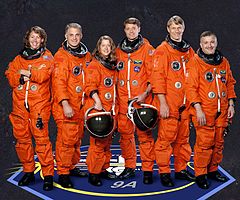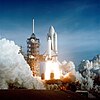STS-112
| Mission emblem | |||
|---|---|---|---|

|
|||
| Mission dates | |||
| Mission: | STS-112 | ||
| COSPAR-ID : | 2002-047A | ||
| Crew: | 6th | ||
| Begin: | October 7, 2002, 19:45:51 UTC | ||
| Starting place: | Kennedy Space Center , LC-39B | ||
| Space station: | ISS | ||
| Coupling: | October 9, 2002, 15:16:15 UTC | ||
| Decoupling: | October 16, 2002, 13:13:30 UTC | ||
| Duration on the ISS: | 6d 21h 57min 15s | ||
| Number of EVA : | 3 | ||
| Landing: | October 18, 2002, 15:43:40 UTC | ||
| Landing place: | Kennedy Space Center, Lane 33 | ||
| Flight duration: | 10d 19h 58min 44s | ||
| Earth orbits: | 170 | ||
| Track height: | Max. 226 km | ||
| Covered track: | 7.2 million km | ||
| Payload: | Lattice structure S1 , CETA A | ||
| Team photo | |||
 v. l. No. Sandra Magnus, David Wolf, Pamela Melroy, Jeffrey Ashby, Piers Sellers, Fjodor Jurtschichin |
|||
| ◄ Before / After ► | |||
|
|||
STS-112 ( english S pace T ransportation S ystem ) is the mission designation for a flight of the US Space Shuttle Atlantis (OV-104) of NASA . The launch took place on October 7, 2002. It was the 111th space shuttle mission, the 26th flight of the space shuttle Atlantis and the 15th flight of a shuttle to the International Space Station (ISS).
team
- Jeffrey Ashby (3rd space flight), commander
- Pamela Melroy (2nd space flight), pilot
-
Fjodor Jurtschichin (1st space flight), mission specialist ( Roskosmos / Russia )

- Sandra Magnus (1st spaceflight), mission specialist
- Piers Sellers (1st spaceflight), mission specialist
- David Wolf (3rd spaceflight), mission specialist
Mission overview
In addition to new experiments, the Atlantis delivered the second lattice structure element to the International Space Station with S1 . The S1 element was mounted on the S0 element that was transported to the station by the STS-110 . A total of three exits were made while the Atlantis was connected to the ISS.
Mission history
After docking on October 9 (3:17 p.m. UTC), preparations were made for relocating the lattice structure element S1 (starboard segment 1). This was lifted out of the loading bay the following day with the help of the shuttle manipulator. It remained here for several hours to adjust the temperature. Then it was transferred to the station's manipulator and coupled to the already installed central part S0. During an exit immediately afterwards (7:01 h), David Wolf and Piers Sellers installed energy, data and coolant lines on the top and bottom of S1. They also loosened several launch brackets on one of the three radiators on S1. These radiators radiate the excess heat from the station and from the solar cell surfaces into space. The work in space also included unfolding, securing and connecting an additional S-band antenna, and releasing launch brackets from a small transport cart (CETA - Crew and Equipment Translation Aid), with which space travelers can move both material and themselves more easily the lattice structure and the installation of a video camera.
Starboard One Truss (S1) is a starboard-mounted segment of the 100 meter long lattice structure of the International Space Station. It is a rigid light metal structure with a trapezoidal cross-section with additional cross struts, which was coupled directly to the central grid segment S0. The grid element is about 13.7 meters long, 4.57 meters wide and has a mass of 13.6 tons. It also has a system for automatic connection to supply lines (energy, data, coolant), a coolant tank, a nitrogen tank, three radiators (approx. 22 m) for radiating excess heat (especially from the energy systems) along with the associated rotary mechanics and control electronics (all parts of the active temperature control system), power converters and distributors, an S-band communication system including antenna, two video connection stations, passive (2) and active (1) segment connection systems and the CETA (Crew and Equipment Translation Aid) trolleys .
CETA is a small mobile platform that can be moved on the rails of the lattice structure. It consists of an aluminum plate with fasteners for payloads attached, with guide wheels, locking devices, shock absorbers and various containers. It has a mass of 283 kg, is 2.50 m long, 2.36 m wide and 0.89 m high. With the outriggers folded in, CETA can be moved from one side of the Mobile Transporter to the other. Both systems use the same rail system.
During the second exit on October 12th (6:04 am), additional connecting lines were laid. In addition, 22 safety devices were installed, which are supposed to guarantee the quick release of connection lines (SPD - Spool Positioning Device). They counteract the build-up of overpressure in the connecting pieces. The coolant lines have to be expanded frequently during the expansion of the station. Therefore, reliably functioning connectors are very important. Wolf and Sellers also installed another video camera (on Destiny ) and renewed a management system for the supply lines on the Mobile Transporter (MT).
The assembly work was completed on October 14 with the third spacecraft (6:36 h). Wolf and Sellers loosened further brackets on the radiators so that one of them could then be extended, connected further supply lines, dismantled brackets and brackets that had become superfluous, which had been necessary during take-off in the payload bay of the Atlantis, and made CETA 1 ready for use.
Between the exits, around 820 kg of supplies, water and experiments, including a mini-greenhouse for Arabidobsis plants, were transported into the station, and around the same amount of experimental material and waste were transported into the shuttle. Materials from completed experiments included liver cell cultures (STELSYS), protein crystal samples (PCG-STES), a small greenhouse (Advanced Astroculture), several plant sample containers (soybeans), zeolite crystal samples, a system for encapsulating drugs in microscopic beads (MEPS) and data carriers. In addition, oxygen, nitrogen and water tanks in the Quest exit module have been refilled. With the engines of the Atlantis, the orbital complex's orbit was raised by almost 10 kilometers. It was also important to replace the vibration damping system on the station's treadmill. The purpose of damping is to ensure that experiments, the course of which depends heavily on good microgravity, produce better results. The movements of the space travelers in the station cause brief forces and thus disturbances in the microgravity .
After decoupling on October 16, the station was partially flown around. High-resolution recordings were made in order to document the expansions precisely. In addition to a few routine examinations, the SHIMMER (Spatial Heterodyne Imager for Mesospheric Ralicals) measurement complex was used both before and after the joint flight of the space shuttle and the station. SHIMMER essentially consists of a UV camera with which the concentration of hydroxyl molecules in the upper atmosphere (40–90 km) can be determined. Conclusions about the nature of the ozone layer can be drawn from the hydroxyl concentration. In addition, a commercially usable system for the controlled maintenance of biological cultures on board the station, in this case of yeast and kidney cells, was used (CGBA - Commercial Generic Bioprocessing Apparatus). The finished samples were immediately taken back to earth.
The landing of the Atlantis at Cape Canaveral took place on October 17 at 15:44 UTC.
Tank camera
For the first time, a camera was attached to the outer shell of the starting Atlantis, which provided video recordings of the start.
See also
Web links
- NASA Mission overview (English)
- Official NASA Mission Page (English)
- NASA video of Mission (English)
- Video summary with comments of the crew (English)


